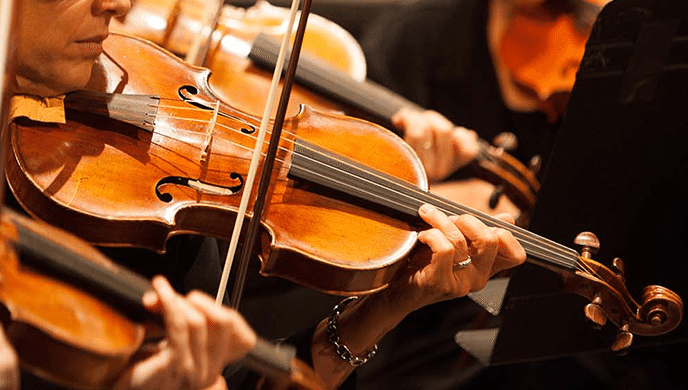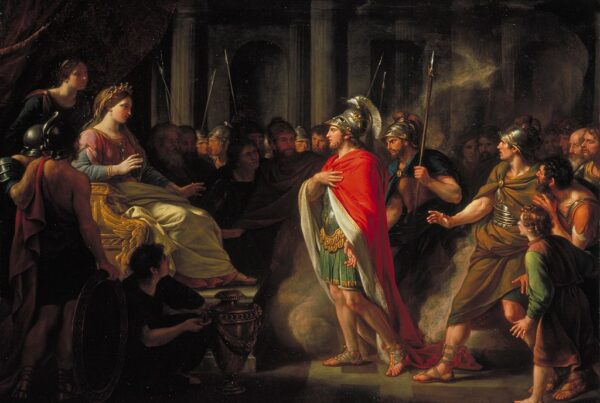Baroque Violin Takes Guts
Bruce Lamott
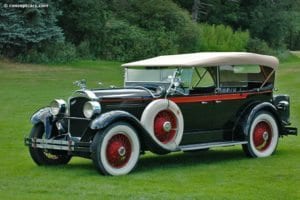
1928 Packard
Imagine a classic car collector who finds that every 1934 Packard had been retrofitted with an air conditioner and power brakes. Such is the situation faced by a Baroque violinist in pursuit of a pristine 17th or 18th century violin that has not undergone “improvements” in the intervening centuries. Most of the string players in Philharmonia perform on instruments made in the 18th century, many of which required a substantial makeover to return them to their original specifications.
Antonio Stradivari (1644-1737) is the best-known of a number of Italian stringed instrument builders (known as luthiers) who flourished in the late 17th and early 18th centuries, and the name Stradivarius has become the familiar gold standard of violins. However, when a modern violin virtuoso, Joshua Bell for example, plays his $4 million Strad, it differs considerably from the instrument that left Antonio’s shop in 1713. While the hourglass-shaped body of the instrument remains roughly the same, the neck, fingerboard, bridge, strings, chinrest (invented by Louis Spohr, a contemporary of Beethoven), and bow have all been altered to accommodate a new approach to virtuosity as well as the acoustical challenges of playing against larger orchestras in bigger concert halls.
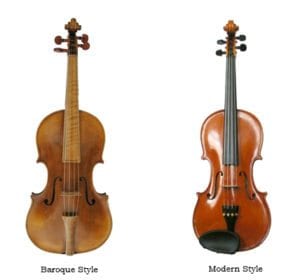
The physical differences between the Baroque violin and its genetically modified modern counterpart are subtle to the naked eye but important to the naked ear. Baroque violin virtuosity – like the vocal style of the Baroque – consists of fleet running passages, dramatic leaps, and expressive ornamental flourishes. The Romantic aesthetic admired brilliance, power, and supersonically high notes over the intricacy, complexity, and extravagance of the Baroque period. Consequently, the modern fingerboard had to be lengthened to allow the left hand to reach notes never encountered in the Baroque repertoire. The addition of a chinrest freed the left hand to play at the extreme end of this elongated fingerboard, while the Baroque violin gently rests on the collarbone of the player. Baroque violins and violas were called da braccio (of the arm), not da mento (of the chin).
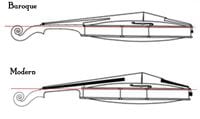 The bridge which lifts the strings up and transmits the vibrations to the belly (or resonance chamber) of the instrument was also raised, and the neck (the part with the scroll and tuning pegs) angled downward in order to put the strings under greater tension. Greater tension, together with steel strings, resulted in a more electric, penetrating sound in the modified instrument.
The bridge which lifts the strings up and transmits the vibrations to the belly (or resonance chamber) of the instrument was also raised, and the neck (the part with the scroll and tuning pegs) angled downward in order to put the strings under greater tension. Greater tension, together with steel strings, resulted in a more electric, penetrating sound in the modified instrument.
The unique sound of the Baroque violin results both from how it is built and how it is played. Strings made from gut (called catgut, but really from sheep) give a more mellow, less strident tone quality.
For a fascinating demonstration of the complex process of making these strings, check out this video:
Gut also allows the Baroque player to use open strings (unstopped by the left hand) freely, without the shrillness of open steel strings, assiduously avoided by the modern player. In Baroque performance practice, vibrato (the rapid oscillation of the left hand which causes a fluctuation in pitch) is used sparingly as an ornament or expressive device, unlike the continuous vibrato of the modern orchestra. This lack of pitch fluctuation gives the Baroque string harmonies a leaner, focused sound in which pinpoint tuning is essential – a challenge further complicated by those quirky stretchable gut strings.

From top; Baroque, transitional and modern Tourte bows.
The shape of the Baroque bows also dictates the sound of the Baroque string section. It is shorter, extremely light, and tapers to a point; it actually somewhat resembles an archery bow. This allows for extremely rapid scales and other ornamental passagework, and a variety of articulations that allows the instrumental music to “speak” as if it had vowels and consonants. The taper of the Baroque bow gives longer notes a dynamic flux, as sustained notes are always in the process of growing or subsiding, while the modern (Tourte) bow was designed to maintain a continuous volume through the long-breathed phrases of Romantic music.
The performance of Baroque violin music on an unmodified instrument has presented challenges to the Baroque violinist. Very few instruments escaped the technological “improvements” of the past 200 years, but some luthiers have been successful in restoring historical instruments to their original configuration. Others are assiduously making replicas of extant instruments in museums. And in the hands of historically informed musicians – the string players of Philharmonia for example – you’ll enjoy a fresh, new listening experience, like riding in that vintage Packard, cooled only by the wind in your face.
Hear the “queen of Baroque violin,” Rachel Podger, perform with Philharmonia Baroque Orchestra & Chorale in a program of violin concertos by Vivaldi, Bach, Tartini and Veracini. Learn more and get tickets below.

